Lexus GX460 2010 Owner's Manual
Manufacturer: LEXUS, Model Year: 2010, Model line: GX460, Model: Lexus GX460 2010Pages: 830, PDF Size: 17.01 MB
Page 351 of 830

350
2-5. Driving information
GX460_CANADA (OM60F29U)
Off-road drivingWhen driving your vehicle off-road, please observe the following precau-
tions to ensure your driving enjoyment and to help prevent the closure of
areas to off-road vehicles:
● Drive your vehicle only in areas where off-road vehicles are permitted
to travel.
● Respect private property. Get owner’s permission before entering pri-
vate property.
● Do not enter areas that are closed. Honor gates, barriers and signs
that restrict travel.
● Stay on established roads. When conditions are wet, driving tech-
niques should be changed or travel delayed to prevent damage to
roads.
■Additional informatio n for off-road driving
For owners in U.S. mainland, Hawaii and Puerto Rico:
To obtain additional information pertaining to driving your vehicle off-road, consult
the following organizations:
●State and Local Parks and Recreation Departments
●State Motor Vehicle Bureau
●Recreational Vehicle Clubs
●U.S. Forest Service and Bureau of Land Management
GX460_CANADA.book Page 350 Thursday, February 4, 2010 11:54 AM
Page 352 of 830

351
2-5. Driving information
2
When driving
GX460_CANADA (OM60F29U)
CAUTION
■Off-road driving precautions
Always observe the following precautions to minimize the risk of death, serious
injury or damage to your vehicle:
●Drive carefully when off the road. Do not take unnecessary risks by driving in
dangerous places.
●Do not grip the steering wheel spokes when driving off-road. A bad bump could
jerk the wheel and injure your hands. Keep both hands and especially your
thumbs on the outside of the rim.
●Always check your brakes for effectiveness immediately after driving in sand,
mud, water or snow.
●After driving through tall grass, mud, rock, sand, rivers, etc., check that there is no
grass, bush, paper, rags, stone, sand, etc. adhering or trapped on the underbody.
Clear off any such matter from the underbody. If the vehicle is used with these
materials trapped or adhering to the underbody, a breakdown or fire could occur.
●When driving off-road or in rugged terrain, do not drive at excessive speeds,
jump, make sharp turns, strike objects, etc. This may cause loss of control or vehi-
cle rollover causing death or serious injury. You are also risking expensive dam-
age to your vehicle’s suspension and chassis.
GX460_CANADA.book Page 351 Thursday, February 4, 2010 11:54 AM
Page 353 of 830
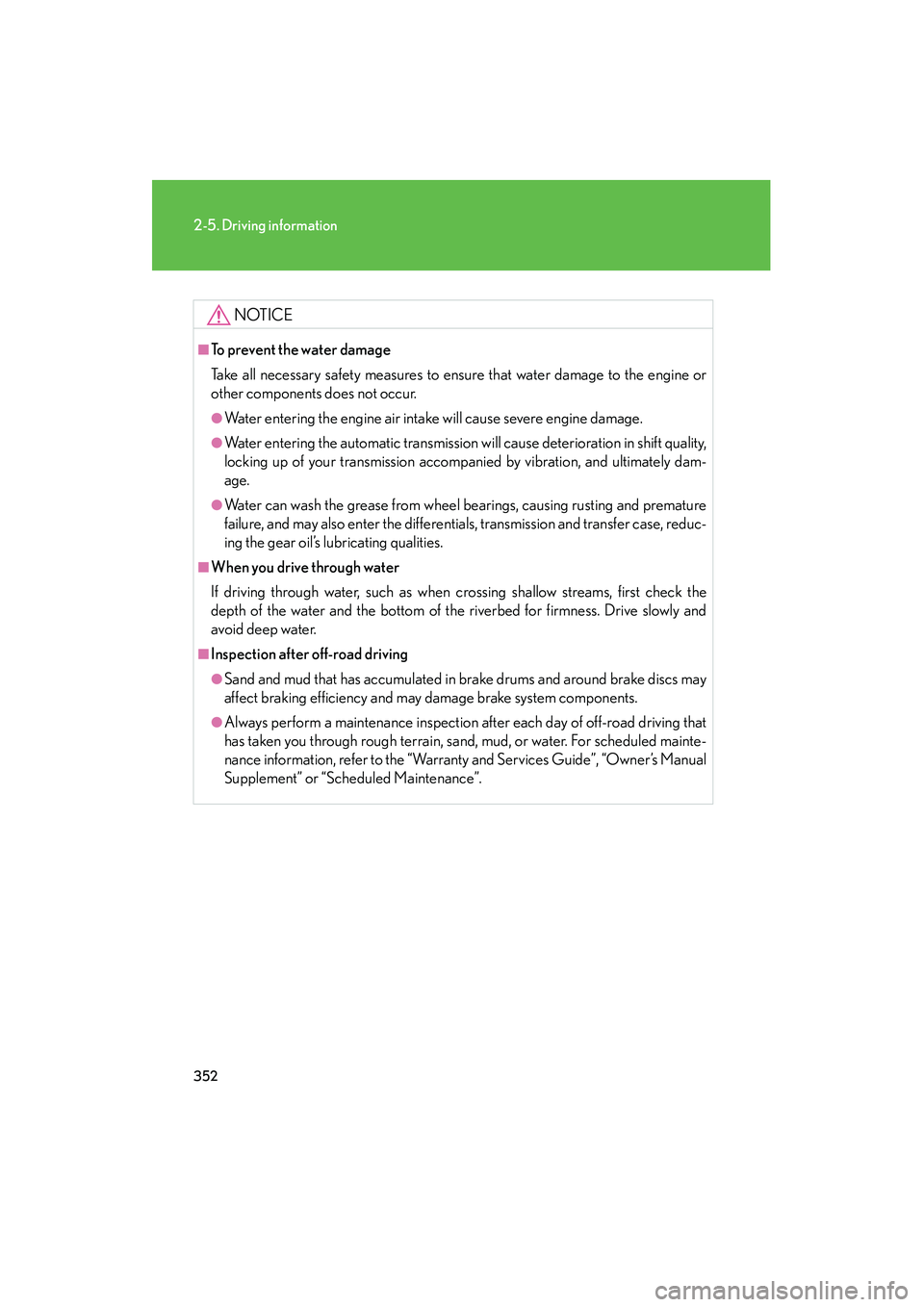
352
2-5. Driving information
GX460_CANADA (OM60F29U)
NOTICE
■To prevent the water damage
Take all necessary safety measures to ensure that water damage to the engine or
other components does not occur.
●Water entering the engine air intake will cause severe engine damage.
●Water entering the automatic transmission will cause deterioration in shift quality,
locking up of your transmission accompanied by vibration, and ultimately dam-
age.
●Water can wash the grease from wheel bearings, causing rusting and premature
failure, and may also enter the differentials, transmission and transfer case, reduc-
ing the gear oil’s lubricating qualities.
■When you drive through water
If driving through water, such as when crossing shallow streams, first check the
depth of the water and the bottom of the riverbed for firmness. Drive slowly and
avoid deep water.
■Inspection after off-road driving
●Sand and mud that has accumulated in brake drums and around brake discs may
affect braking efficiency and may damage brake system components.
●Always perform a maintenance inspection after each day of off-road driving that
has taken you through rough terrain, sand, mud, or water. For scheduled mainte-
nance information, refer to the “Warranty and Services Guide”, “Owner’s Manual
Supplement” or “Scheduled Maintenance”.
GX460_CANADA.book Page 352 Thursday, February 4, 2010 11:54 AM
Page 354 of 830
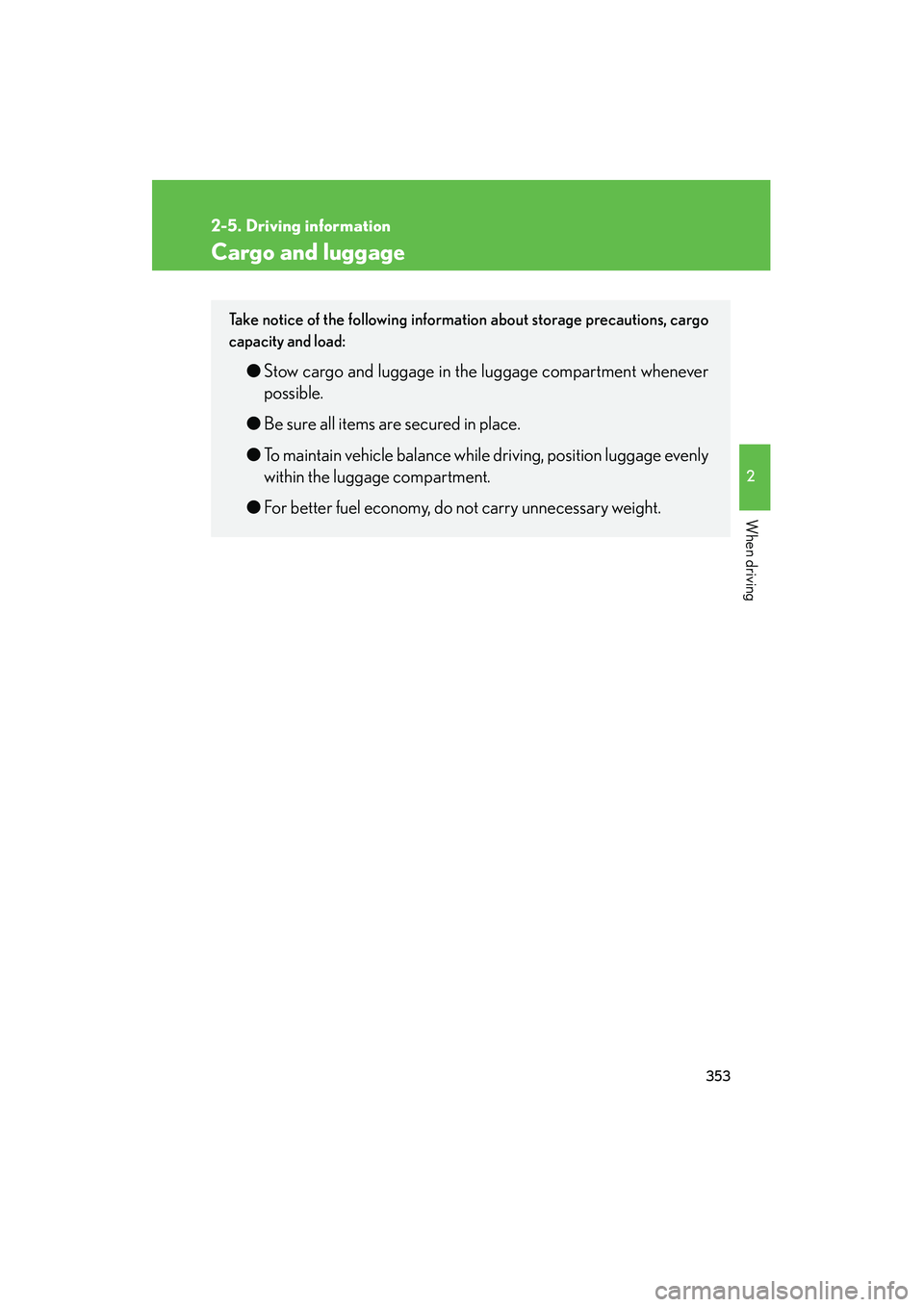
353
2-5. Driving information
2
When driving
GX460_CANADA (OM60F29U)
Cargo and luggage
Take notice of the following information about storage precautions, cargo
capacity and load:
●Stow cargo and luggage in the luggage compartment whenever
possible.
● Be sure all items are secured in place.
● To maintain vehicle balance while driving, position luggage evenly
within the luggage compartment.
● For better fuel economy, do not carry unnecessary weight.
GX460_CANADA.book Page 353 Thursday, February 4, 2010 11:54 AM
Page 355 of 830
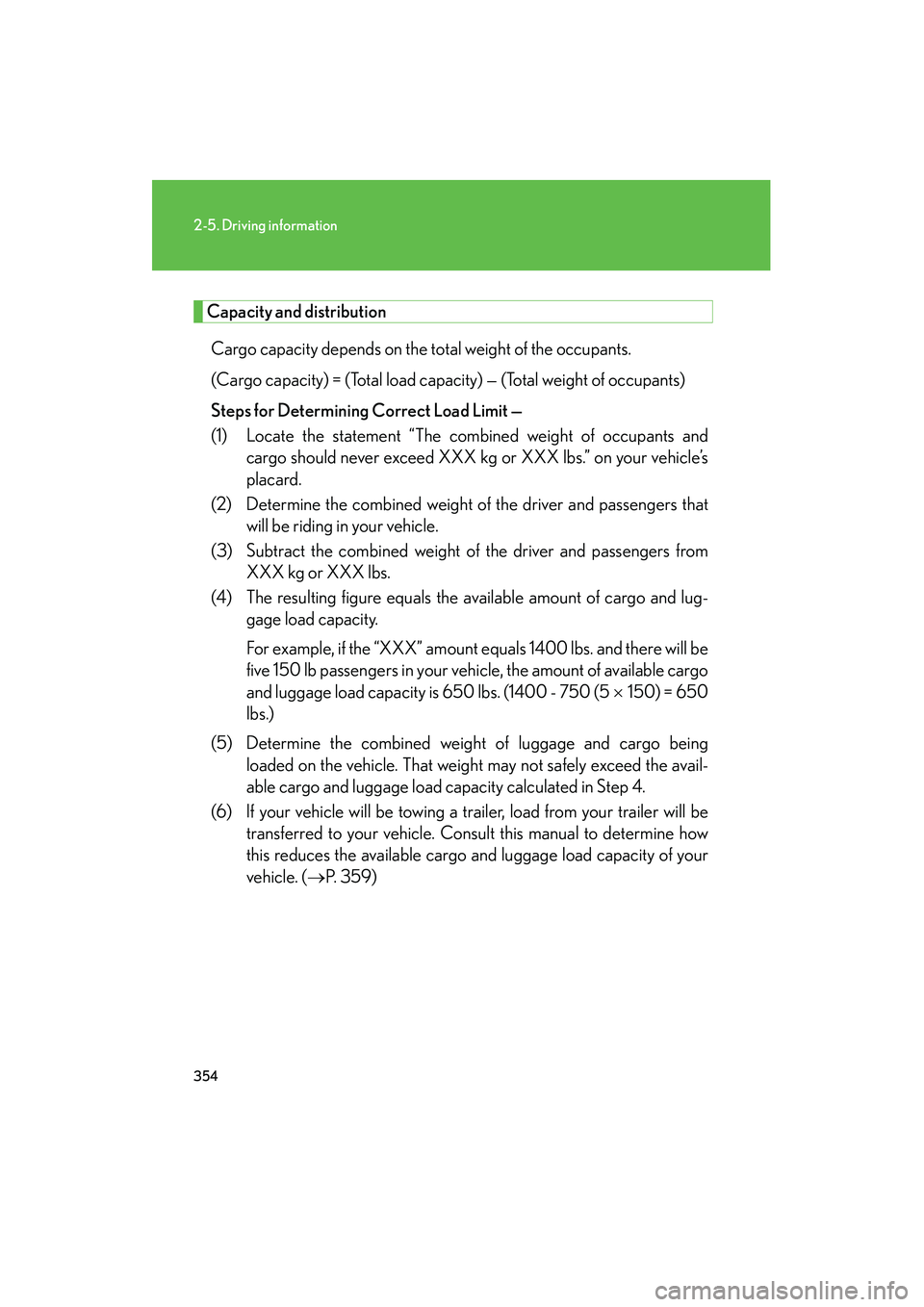
354
2-5. Driving information
GX460_CANADA (OM60F29U)
Capacity and distributionCargo capacity depends on the total weight of the occupants.
(Cargo capacity) = (Total load cap acity) — (Total weight of occupants)
Steps for Determining Correct Load Limit —
(1) Locate the statement “The combined weight of occupants and cargo should never exceed XXX kg or XXX lbs.” on your vehicle’s
placard.
(2) Determine the combined weight of the driver and passengers that will be riding in your vehicle.
(3) Subtract the combined weight of the driver and passengers from XXX kg or XXX lbs.
(4) The resulting figure equals the available amount of cargo and lug- gage load capacity.
For example, if the “XXX” amount equals 1400 lbs. and there will be
five 150 lb passengers in your vehicle, the amount of available cargo
and luggage load capacity is 650 lbs. (1400 - 750 (5 × 150) = 650
lbs.)
(5) Determine the combined weight of luggage and cargo being loaded on the vehicle. That weight may not safely exceed the avail-
able cargo and luggage load capacity calculated in Step 4.
(6) If your vehicle will be towing a trailer, load from your trailer will be transferred to your vehicle. Consult this manual to determine how
this reduces the available cargo and luggage load capacity of your
vehicle. ( →P. 359)
GX460_CANADA.book Page 354 Thursday, February 4, 2010 11:54 AM
Page 356 of 830
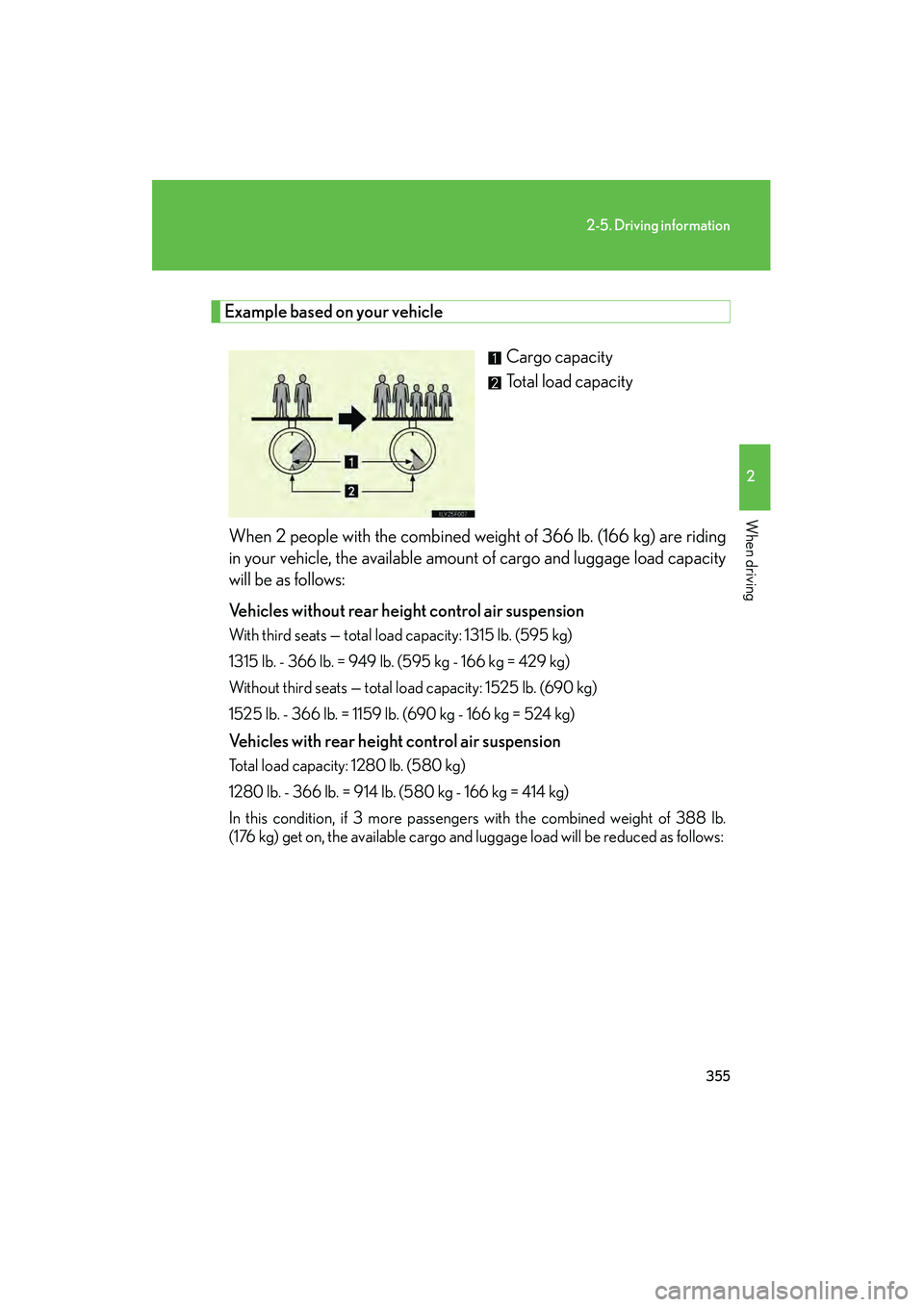
355
2-5. Driving information
2
When driving
GX460_CANADA (OM60F29U)
Example based on your vehicleCargo capacity
Total load capacity
When 2 people with the combined weight of 366 lb. (166 kg) are riding
in your vehicle, the available amount of cargo and luggage load capacity
will be as follows:
Vehicles without rear height control air suspension
With third seats — total load capacity: 1315 lb. (595 kg)
1315 lb. - 366 lb. = 949 lb. (595 kg - 166 kg = 429 kg)
Without third seats
— total load capacity: 1525 lb. (690 kg)
1525 lb. - 366 lb. = 1159 lb. (690 kg - 166 kg = 524 kg)
Vehicles with rear heig ht control air suspension
Total load capacity: 1280 lb. (580 kg)
1280 lb. - 366 lb. = 914 lb. (580 kg - 166 kg = 414 kg)
In this condition, if 3 more passengers with the combined weight of 388 lb.
(176 kg) get on, the available cargo and lugga ge load will be reduced as follows:
GX460_CANADA.book Page 355 Thursday, February 4, 2010 11:54 AM
Page 357 of 830

356
2-5. Driving information
GX460_CANADA (OM60F29U)Vehicles without rear heig
ht control air suspension
With third seats
949 lb. - 388 lb. = 561 lb. (429 kg - 176 kg = 253 kg)
Without third seats
1159 lb. - 388 lb. = 771 lb. (524 kg - 176 kg = 348 kg)
Vehicles with rear height control air suspension
914 lb. - 388 lb. = 526 lb. (414 kg - 176 kg = 238 kg)
As shown in the example above, if the number of occupants increases,
the cargo and luggage load will be reduced by an amount that equals the
increased weight due to the additional occupants. In other words, if an
increase in the number of occupants causes an excess of the total load
capacity (combined weight of occupa nts plus cargo and luggage load),
you must reduce the cargo and luggage on your vehicle.
CAUTION
■Things that must not be carri ed in the luggage compartment
The following things may cause a fire if loaded in the luggage compartment:
●Receptacles containing gasoline
●Aerosol cans
GX460_CANADA.book Page 356 Thursday, February 4, 2010 11:54 AM
Page 358 of 830
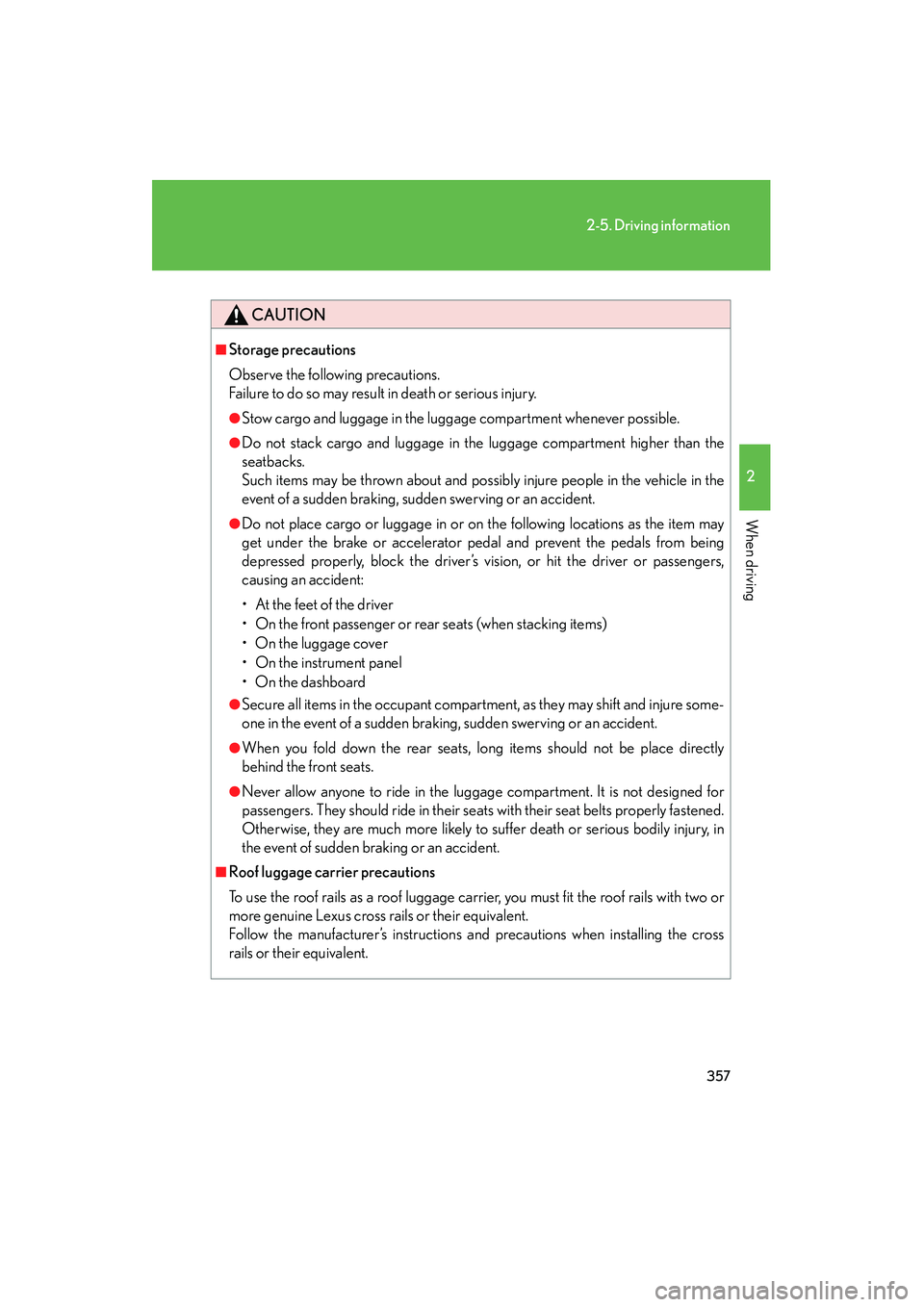
357
2-5. Driving information
2
When driving
GX460_CANADA (OM60F29U)
CAUTION
■Storage precautions
Observe the following precautions.
Failure to do so may result in death or serious injury.
●Stow cargo and luggage in the luggage compartment whenever possible.
●Do not stack cargo and luggage in the luggage compartment higher than the
seatbacks.
Such items may be thrown about and possibly injure people in the vehicle in the
event of a sudden braking, sudden swerving or an accident.
●Do not place cargo or luggage in or on the following locations as the item may
get under the brake or accelerator pedal and prevent the pedals from being
depressed properly, block the driver’s vision, or hit the driver or passengers,
causing an accident:
• At the feet of the driver
• On the front passenger or rear seats (when stacking items)
• On the luggage cover
• On the instrument panel
• On the dashboard
●Secure all items in the occupant compartment, as they may shift and injure some-
one in the event of a sudden braking, sudden swerving or an accident.
●When you fold down the rear seats, long items should not be place directly
behind the front seats.
●Never allow anyone to ride in the luggage compartment. It is not designed for
passengers. They should ride in their seats with their seat belts properly fastened.
Otherwise, they are much more likely to suffer death or serious bodily injury, in
the event of sudden braking or an accident.
■Roof luggage carrier precautions
To use the roof rails as a roof luggage carrier, you must fit the roof rails with two or
more genuine Lexus cross rails or their equivalent.
Follow the manufacturer’s instructions and precautions when installing the cross
rails or their equivalent.
GX460_CANADA.book Page 357 Thursday, February 4, 2010 11:54 AM
Page 359 of 830
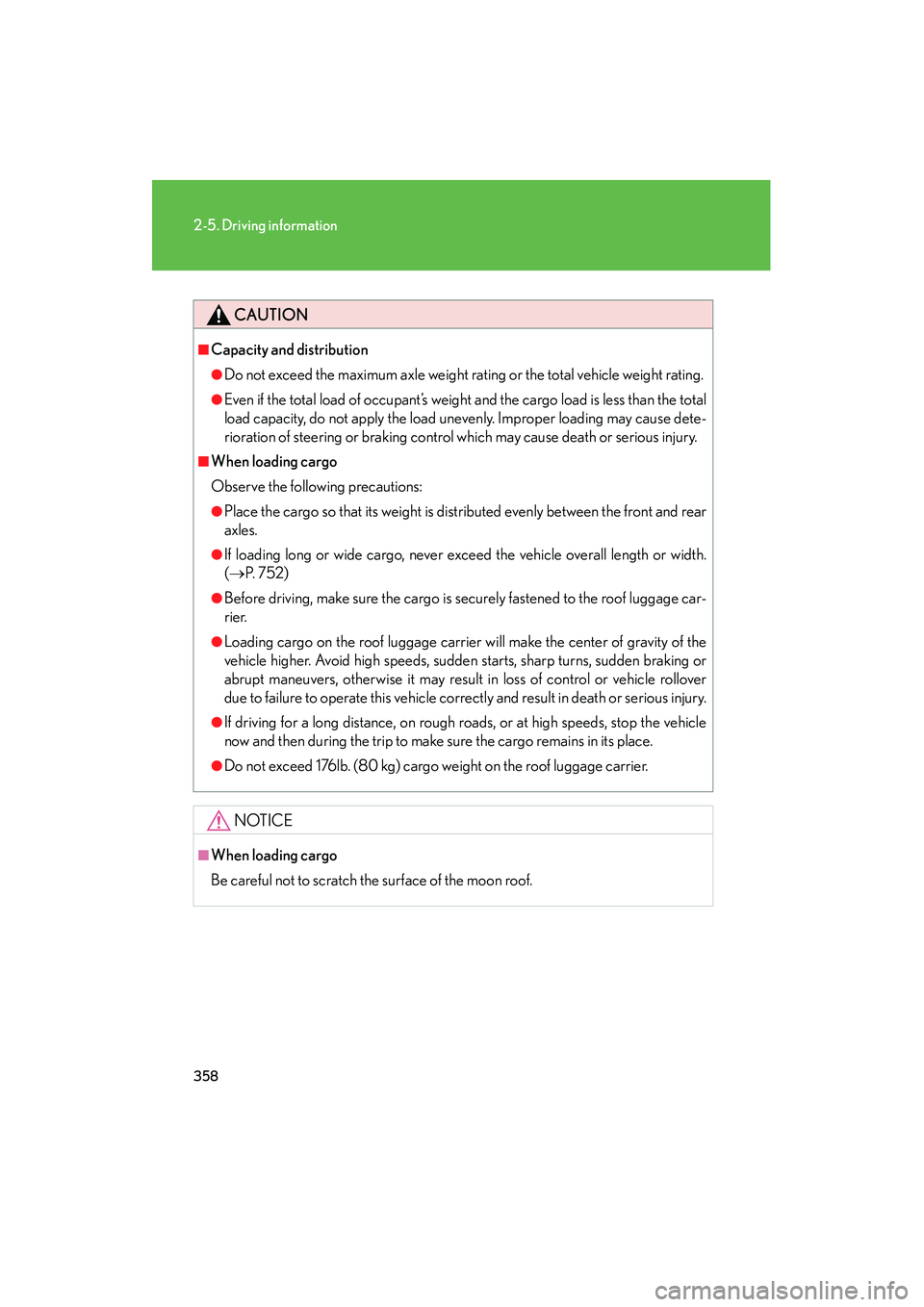
358
2-5. Driving information
GX460_CANADA (OM60F29U)
CAUTION
■Capacity and distribution
●Do not exceed the maximum axle weight rating or the total vehicle weight rating.
●Even if the total load of occupant’s weight and the cargo load is less than the total
load capacity, do not apply the load unevenly. Improper loading may cause dete-
rioration of steering or braking control which may cause death or serious injury.
■When loading cargo
Observe the following precautions:
●Place the cargo so that its weight is distributed evenly between the front and rear
axles.
●If loading long or wide cargo, never exceed the vehicle overall length or width.
(→ P. 7 5 2 )
●Before driving, make sure the cargo is securely fastened to the roof luggage car-
rier.
●Loading cargo on the roof luggage carrier will make the center of gravity of the
vehicle higher. Avoid high speeds, sudden starts, sharp turns, sudden braking or
abrupt maneuvers, otherwise it may result in loss of control or vehicle rollover
due to failure to operate this vehicle correctly and result in death or serious injury.
●If driving for a long distance, on rough roads, or at high speeds, stop the vehicle
now and then during the trip to make sure the cargo remains in its place.
●Do not exceed 176lb. (80 kg) cargo weight on the roof luggage carrier.
NOTICE
■When loading cargo
Be careful not to scratch the surface of the moon roof.
GX460_CANADA.book Page 358 Thursday, February 4, 2010 11:54 AM
Page 360 of 830
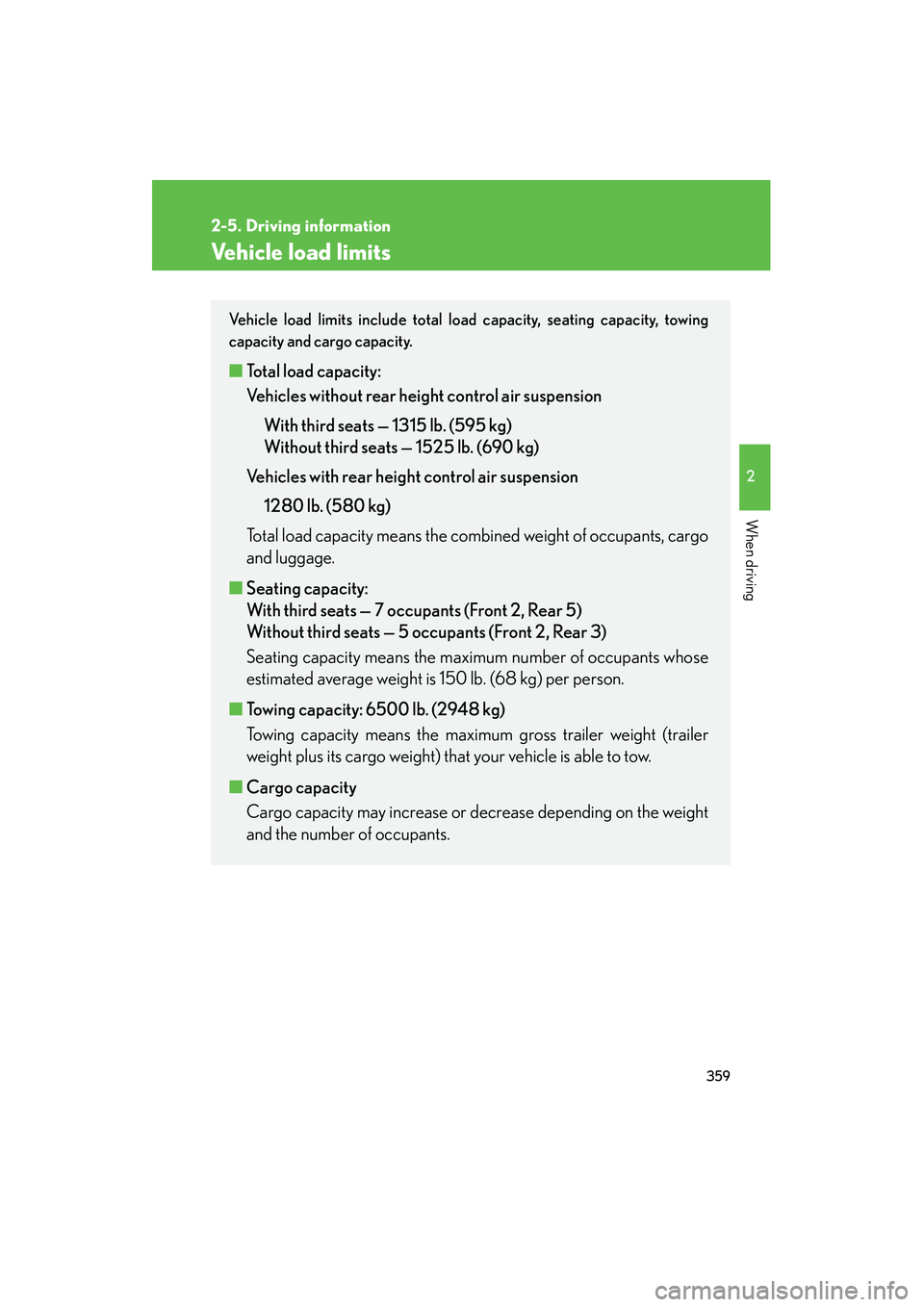
359
2-5. Driving information
2
When driving
GX460_CANADA (OM60F29U)
Vehicle load limits
Vehicle load limits include total load capacity, seating capacity, towing
capacity and cargo capacity.
■Total load capacity:
Vehicles without rear height control air suspension
With third seats — 1315 lb. (595 kg)
Without third seats — 1525 lb. (690 kg)
Vehicles with rear height control air suspension 1280 lb. (580 kg)
Total load capacity means the combined weight of occupants, cargo
and luggage.
■ Seating capacity:
With third seats — 7 occupants (Front 2, Rear 5)
Without third seats — 5 occupants (Front 2, Rear 3)
Seating capacity means the maximu m number of occupants whose
estimated average weight is 150 lb. (68 kg) per person.
■ Towing capacity: 6500 lb. (2948 kg)
Towing capacity means the maximum gross trailer weight (trailer
weight plus its cargo weight) that your vehicle is able to tow.
■ Cargo capacity
Cargo capacity may increase or decrease depending on the weight
and the number of occupants.
GX460_CANADA.book Page 359 Thursday, February 4, 2010 11:54 AM